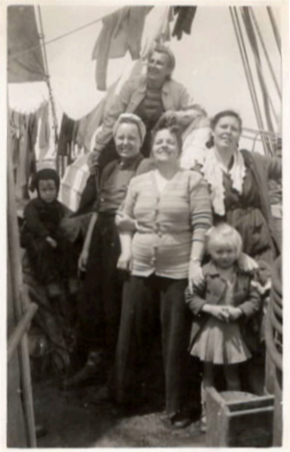Boats

The W.E. Gladstone
W.E. GLADSTONE
“Buffeted and battered by Atlantic gales for 16 days, a hazardous ocean crossing terminated here Saturday night when a tiny Swedish motor vessel reached Halifax safely with 23 Estonian refugees. Happy over the prospect of starting life anew in a free country, the refugees dismissed the risk of their stormy crossing as well worth being rid of the menace of deportation to Red concentration camps.”
Halifax Chronicle Herald, July 18, 1949
On June 23, 1949, the W.E. Gladstone departed “for a pleasure cruise” from Lysekil, Sweden, with 10 men, nine women, and four children on board. Its captain, Teodor Vompa (Theodor Wompa), was an experienced Estonian seaman who had graduated in the second class of Tallinn Maritime School in 1925. He had escaped from Estonia in 1944 on board the Swedish steamer Raugi.

Captain Theodor Wompa, his wife, Heljo, and children from the Gladstone.
“‘When we first came to Sweden, we thought eventually we could go back to Estonia,’ explained Capt. Vompa. But two years ago, [we] became convinced this was impossible, and began to lay plans for the journey to Canada. The Estonians said that in Sweden, ‘we could not own land there or run a business—we would always be foreigners.’ And it was ‘too close to Russia.’”
The Windsor-Ontario Star, July 18, 1949
In 1949, Vompa and his father-in-law, Jaan Lindpere, bought the Gladstone, a fishing boat built in England in 1894. The vessel was 71.2 feet long (21.78 meters), 18.5 feet wide (5.63 meters), and had a 150 HP diesel engine. The 32-ton, two-masted schooner was registered as a hobby or pleasure craft, which reduced the requirements to leave Sweden but also limited the number of people allowed on board.
After leaving Sweden, the Gladstone encountered rough weather in the North Sea and pulled into Sligo, Ireland, on June 29. During the stopover, local residents showed the refugees around and were “very friendly and treated us very kindly,” a passenger recalled. After resupplying the food and fuel, the ship began the transatlantic journey on July 2. For the first eight days, the sun never broke through, making it difficult to use the sextant. But on July 16, the Gladstone reached Halifax, Canada. The entire voyage, including the stop in Ireland, had taken only 23 days.

Women and children on board.
Vompa described the voyage to Canadian journalists as, “Over 2,000 miles of ocean sailing on a horse.” This was no exaggeration because the only seat in the boat’s tiny seven-by-five-foot chart and wheelhouse was a crudely built wooden horse padded with a cushion.
Most of the refugees had obtained visas before leaving Sweden from the Canadian consulate in Stockholm and were able to enter the country. In Estonia, they had worked in shipbuilding, fishing, sealing, and farming and hoped to do the same kind of labor in Canada, preferably in Nova Scotia, which reminded them of home.
Known crew and passengers:
- Captain Teodor Vompa (Theodor Wompa) and his wife, Heljo
- Johannes Silberberg
- Aalnan Lydia
- Uno Kabel and his mother, Marta
- Bernhard Schmuul
- Herbert Schmuul
- Linda Vaide
Photographs courtesy of the Wompa family.
